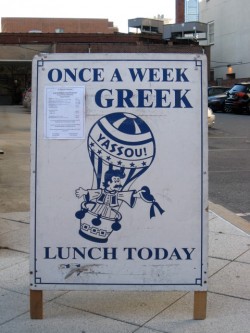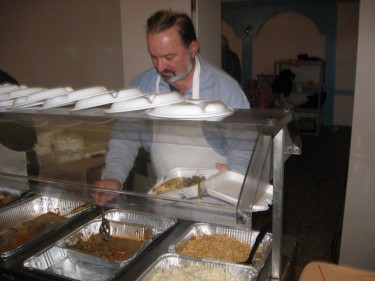Eat, Pray, Judge: Pastitsio With The Greek Orthodox
by Dan Packel

I’ve always been under the impression that religious spaces were designed to invoke awe in the power of the divine. I’m thinking of the flying buttresses and soaring ceilings of Gothic cathedral architecture, or the sweeping scale and towering minarets of Delhi’s Jama Masjid — extreme examples, for sure. Yet I also presumed that even neighborhood places of worship aimed for similar aesthetic splendor. And maybe that’s the case in their spaces dedicated to prayer. But the spaces where religious groups offer food? Well, as far as I’ve been able to gather during this project to eat cheaply (and satisfyingly, if possible) from the hands of the believers — not so much.
Perhaps this point would be obvious to those who regularly attend church (or synagogue, Bahá’í temple, etc.) or were once active members of a religious community. But while my mother faithfully went to Catholic mass every Saturday evening, I never stepped through the door there, nor did I have anything to do with the Jewish services that were the birthright of both my parents. (The Jewish to Catholic trajectory of my mom’s life, long story.) I’m not sure quite what I expected from religiously affiliated dining halls, but the kitschy grandeur (and white tablecloths) enjoyed by Scientologists appears more and more the exception.
My education in the homely nature of in-church dining spaces continued at Saint George’s Greek Orthodox Cathedral in Philadelphia, which serves lunch to anyone who’s inclined every Friday. The cathedral itself was built in the first half of the nineteenth century by noted architect Thomas Haviland — perhaps most famous for his commission of Eastern State Penitentiary. It’s beautiful, indeed, but for Friday lunches, rather than ascending the steps underneath ionic columns to enter the historic cathedral, visitors skirt the building, heading directly through a pair of modern glass doors in the back, into the community center.
When my friend Jack and I arrived at 1 p.m., attendance in the large hall was sparse. The crowd, such as it was, was sprinkled across ten round tables, each covered with a sheet of thin plastic and holding a vase filled with plastic flowers. Overhead hung three large but austere chandeliers. There were blue splashes on the white walls; these came from posters scattered around the room issued by the Board of Tourism of the Republic of Greece — various images of Aegean seascapes with fishing boats in the foreground and cloudless Mediterranean skies. Despite the posters, the room had a civic cum gymnasium feel to it; push the tables to the side of the room, and I would have been ready to step into a booth and vote — perhaps for whether I preferred the Cyclades to the Peloponnesian Peninsula. From unseen speakers, Greek music filled the air at low volume.

We went to the buffet table and picked up a printed menu: a first for me in these forays. Baked salmon, moussaka, pastitsio, along with roast chicken and lamb shanks. Prices were hefty here, especially compared to the free meals I’d partaken in at earlier stops; the platters ranged from eight to ten dollars, depending on choice of entrée.
Passing up the priciest options, I asked one of the two men standing behind the buffet table for the moussaka, described on the menu as “baked eggplant & potatoes with meat sauce au gratin.” But in a spot of confusion, he started serving me pastitsio instead, and I told him to keep it coming. “It’s like a Greek lasagna,” he informed me in accented English. Confused by certain ambiguities on the menu I had just read, when choosing sides to be added to my plastic plate I overlooked the green beans and walked away having been served both rice and orzo. Conveniently ridged into three compartments, my plate now hosted starch (with meat), starch, and starch. I consoled myself with the thought that it was a cold day outside. I paid my eight dollars to the women conversing in Greek behind the register and grabbed a complimentary piece of bread. Like an auctioneer instituting a minimum bid, I was determined to extract full value from my meal — even if this entailed more starch.
Seated at a table, I imagined a competition between my various starch items, victory going to whichever item seemed to have received the most butter. The tubular pasta beneath the meat sauce in the pastitsio seemed like it had received a generous supplement, and the top layer of the dish was topped with a creamy layer of béchamel that had set. Both my orzo and rice also seemed liberally tossed in butter. Not wanting to be accused of playing favorites, I spread butter from a plastic blister pack onto my bread. There were no losers in this matchup, except, perhaps, my cardiac health.
Any romantic notion I might have held on this January day of sun-dappled olive groves and the heart-friendly character of the Mediterranean diet was dissolving in a pool of warm butter.
The pool of diners thinned out further. Those remaining had clustered into isolated groups of conversation: the three women behind the register; the two men behind the buffet table; one table over, two older fellows, both sporting black Greek Fishermen’s caps that pushed the authenticity meter a notch higher. All of them seemed to be speaking in Greek.
The music grew more insistent as the level of chatter in the room declined. With leaden bellies, we picked up our empty plates and dumped then into a wastebasket. Eager for acknowledgement, I waved farewell to the men behind the buffet, earning a half-hearted response from one. Jack and I exited into the shadows cast by the cathedral, our next destination a bar up the street.
Previously: Bean Pie With The Nation Of Islam Pancakes With The Episcopalians and Lunch With The Sikhs
Dan Packel writes about food (and more!) from his home in Philadelphia. You can also follow him here.
